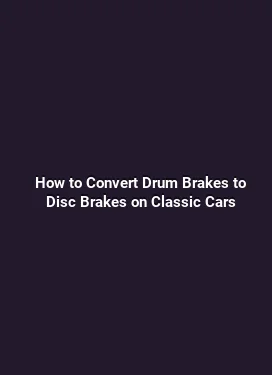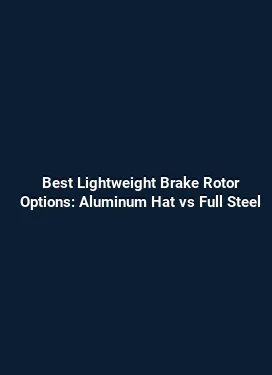Brembo GT vs AP Racing Brake Kit: A Comprehensive Comparison for Track Day Cars
Understanding Track Day Brake Systems: Core Principles Behind High-Performance Kits

Track day brake kits are engineered to deliver consistent stopping power under demanding conditions, where heat buildup, fade resistance, and pedal feel dictate lap times and driver confidence. Core considerations include rotor metallurgy, caliper rigidity, pad compound compatibility, and fluid boiling thresholds. Brembo GT and AP Racing represent two of the most respected families in this space, each prioritizing distinct approaches to weight distribution, cooling efficiency, and real-world behavior on a closed circuit. A well-matched kit aligns with the vehicle’s weight distribution, driving style, and track profile, enabling predictable bite, linear progression, and stable modulation across multiple hot laps.
Beyond raw stopping power, the practical value of a brake kit lies in thermal management and repeatability. Elevated temperatures can cause pad and rotor deformation, introduce brake fade, and shift friction coefficients. This is where design details—such as vented rotor geometry, piston area, pad shape, and seal integrity—play a decisive role. For track enthusiasts, understanding how Brembo GT and AP Racing approach these challenges helps in selecting a setup that not only stops effectively in a straight line but also provides confidence in corner entry and late-braking performance.
Key Design Philosophies: Brembo GT vs AP Racing
Brembo GT kits are known for a balance between high braking performance and smooth modulation, with a focus on rotor durability and consistent bite under sustained heat. The GT line often emphasizes lighter caliper bodies and carefully tuned pad compounds to deliver a progressive feel that drivers can rely on lap after lap. A distinctive advantage is Brembo’s broad rotor options, including high-performance iron rotors and advanced composite alternatives in specific applications, which contribute to favorable heat dissipation and resistance to warping under track conditions.
AP Racing, in contrast, places significant emphasis on stiffness, braking torque, and aggressive initial bite, with many configurations designed to maximize stopping power for competitive track use. AP Racing kits frequently incorporate robust caliper bodies, optimized piston diameters, and specialized pad compounds structured to maintain friction stability at elevated temperatures. The result is a system that can deliver sharp initial deceleration while preserving control at the limit, a characteristic that many drivers associate with high-track-speed confidence.
Rotor and Caliper Architecture: Mass, Stiffness, and Heat Path

Rotor design is a foundational element of any track-day brake kit. Brembo GT rotors typically prioritize efficient heat dispersion through optimized vane patterns and rotor mass that supports consistent thermal behavior without excessive unsprung weight. The choice between iron rotors and specialized composites (where available) influences heat soak resistance, rotor warp tendencies, and pad wear rates. Caliper architecture—whether monoblock or multi-piston configurations—affects piston alignment, clamping force distribution, and the ability to maintain even pad wear across the rotor surface.
AP Racing often pursues high structural rigidity in the caliper assembly, using materials and geometries that minimize flex under load. A stiffer caliper translates to more precise pad contact and improved modulation, particularly as rotor temperatures rise. The combination of piston geometry and pad backing materials can contribute to a more aggressive initial bite while still offering a controlled fade profile. In practice, this balance helps track drivers manage late-braking and mid-c corner deceleration with reduced pedal travel variability.
Pad Technology, Friction, and Heat Management
Pad compounds are central to how a brake kit behaves across a range of temperatures and driving styles. Brembo GT systems typically rely on compounds designed for a broad temperature window, delivering predictable friction coefficients from cold to near-thermal equilibrium. The goal is a linear response that allows drivers to gauge deceleration with confidence, supporting smooth trail braking and precise brake release. Pad wear rates, limited by material formulation and backing plate design, influence maintenance intervals and total cost of ownership during track seasons.
AP Racing often leverages compounds engineered to sustain friction stability at higher temperatures, delivering strong initial bite and robust peak torque. This can translate to shorter stopping distances at the track, with a focus on maintaining consistent performance under repetitive heat cycles. For users who frequently push their cars to the limit, AP Racing’s approach may offer an advantage in spatially compact kinematics, allowing sharper deceleration without excessive pedal travel as temperatures climb.
Fluid Compatibility, Heat Cycling, and Caliper Cooling
Brake fluid quality and boiling resistance are essential when track sessions push systems beyond ordinary road use. Both Brembo GT and AP Racing kits assume high-performance fluid choices and proper system sealing to minimize risk of vapor lock during intense braking. Effective cooling solutions—such as rotor venting, caliper ducts, and rotor hats—help maintain peak performance by reducing heat soak into the pad and caliper seals. A well-planned cooling strategy can extend pad life, stabilize friction, and preserve pedal feel even on longer endurance-style sessions.
When assessing kits, consider how each brand suggests routing and routing hardware for ducts, how rotor designs affect cooling pathways, and whether caliper pistons are exposed to cooling air or shielded by the rotor hub. In practice, a system that manages heat efficiently maintains a more consistent bite throughout the stint and reduces the tendency for pedal fade as repeated braking cycles accumulate.
Installation Fitment, Vehicle Compatibility, and Weight Considerations
Fitment is a practical determinant that extends beyond raw braking performance. Vehicle compatibility involves rotor diameter, spoke pattern, wheel clearance, and caliper mounting rigidity. Brembo GT kits are often offered with a broad range of mounting adapters and carrier configurations to suit various platforms, with attention to maintaining unsprung weight within a performance-friendly envelope. Lighter components can contribute to improved suspension responsiveness and steerable feel, which in turn affects how the brakes are perceived during aggressive corner entries.
AP Racing kits frequently emphasize robust hardware and precise rotor-to-hub alignment to optimize pad contact across a wide operating temperature span. Caliper weight and mounting interface choices can influence steering feel and chassis balance, particularly on mid-engine or rear-wheel-drive configurations where brake bias interacts with weight distribution. In addition to rotor and caliper weight, the overall system may include perch brackets, bleed screws, and sensor compatibility that impact the ease of installation and maintenance between track days.
Choosing Between Brembo GT and AP Racing for Your Track Day Car
The decision rests on how the car’s dynamics, the driver’s style, and the typical track profile align with each brand’s strengths. For drivers seeking a progressive, predictable brake feel with steady fade resistance across long sessions, Brembo GT can be an excellent match due to its emphasis on balanced bite and broad temperature operability. For competitors and drivers who prioritize sharp initial deceleration, peak braking power, and pronounced pedal feedback at the limit, AP Racing often delivers a compelling advantage through stiffer calipers and aggressive friction behavior.
Practical steps to ensure a successful selection include evaluating the following: rotor size constraints relative to wheel clearance, the track’s typical ambient temperature, the vehicle’s weight distribution, and the driver’s preferred braking cadence. Consulting with a qualified brake technician who can model heat transfer, simulate pad wear, and verify caliper alignment for your specific track configuration is highly recommended. This collaborative approach helps ensure that the chosen kit not only achieves strong braking but also preserves reliability and driveability on a full weekend of track activity.
Practical Comparisons: Real-World Scenarios and Benchmarks
Imagine a mid-sized track-ready sports car with a balanced chassis and a driver who alternates heavy braking into high-speed corners. In a Brembo GT configuration, the setup might yield a smooth torque curve that remains consistent as the brake system heats up, enabling controlled modulation into tight apexes. This profile suits drivers who value linear response and a forgiving transition from heavy deceleration to mid-corner speed maintenance. The system’s heat dissipation characteristics are optimized to prevent rapid degradation in bite as sessions extend beyond 15-20 minutes of continuous braking.
In the AP Racing scenario, the same vehicle could benefit from an aggressive initial bite, helping the driver establish early entry speeds and maintain the desired trajectory through late braking. The higher performance emphasis can translate into shorter stopping distances under race-like conditions, though it may require careful baseline setup to avoid pedal feel becoming too abrupt for some drivers during repeated laps. For endurance sessions, attention to pad wear rates and rotor cooling becomes essential, since maintaining stability across multiple heat cycles is crucial to consistent performance.
Maintenance and Service Considerations
Maintenance for track day brake kits includes regular inspection of rotor wear, pad thickness, and caliper pistons. Bleeding the system to ensure hydraulic efficiency, checking fluid quality, and confirming rotor runout are routine tasks that support reliability. Brembo and AP Racing both provide service guidelines tailored to their kits, including recommended pad compounds for different track temperatures, rotor replacement intervals based on activity level, and torque specifications for mounting hardware. Following these guidelines helps sustain performance and reduces the risk of unexpected issues at the track.
Another practical aspect is upgrade path compatibility. If a future upgrade is anticipated, consider how each brand’s kits integrate with existing wheels, brake lines, ABS sensors, and vehicle electronics. Some drivers prefer kits that minimize the need for major chassis modifications, preserving consistency across a range of configurations and ensuring smoother transitions between street and track setups.
Trend Elements and Semantic Context in Modern Brake Systems
Current trends in brake system design emphasize thermal management, friction stability across a wide temperature range, and predictable modulation under load. The integration of advanced materials, such as high-friction alloys and optimized backing plates, supports longer pad life without sacrificing feel. In practice, drivers experience more consistent performance during repeated hard braking, with reduced abrupt changes in pedal travel as components heat and cool. LSI-friendly concepts in this space include heat soak mitigation, clutch-like modulation in braking, and the relationship between brake torque and vehicle balance during corner entry. These elements collectively inform how Brembo GT and AP Racing configurations behave on track days and influence long-term satisfaction with the upgrade.
For enthusiasts who track multiple times per year, a strategic choice may revolve around selecting a kit that harmonizes with the car’s suspension tuning, tire strategy, and driving preferences. A well-matched system reduces the need for frequent changes in pad compounds and rotor materials, delivering a more streamlined maintenance lifecycle and a better overall driving experience during competitive sessions.
Summary of Practical Guidance for Track Day Success
To maximize performance when choosing between Brembo GT and AP Racing brake kits, focus on three practical pillars: brake modulation and feedback, heat management and fade resistance, and installation compatibility with your vehicle. By aligning the kit’s strengths with the driver’s preferred braking style and the track’s demands, you can achieve reliable stopping power, improved lap consistency, and reduced maintenance complexity across a season of track days.






